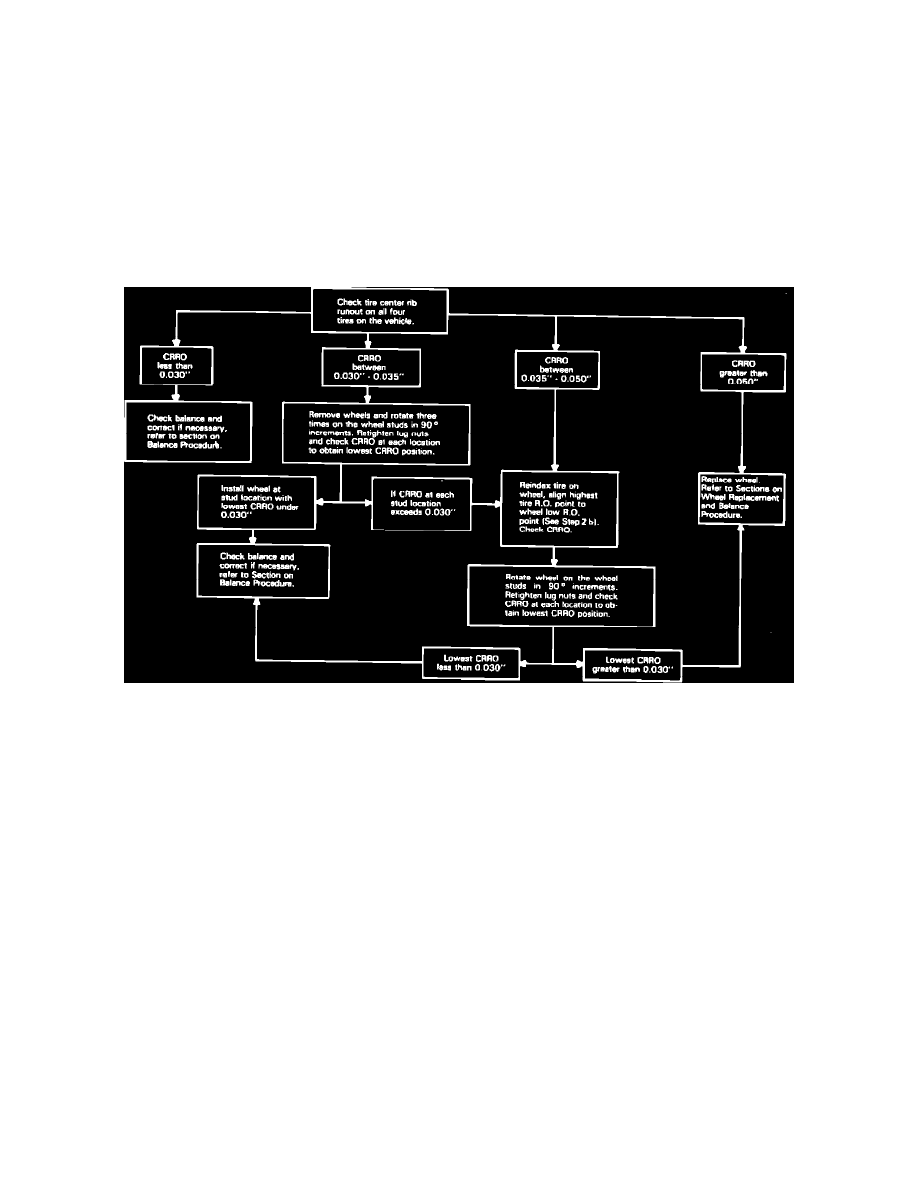Tempo L4-122 2.0L DSL (1984)

last for less than 5~ of the tire circumference. These "spikes" can be caused by tire irregularities but do not affect ride. (See Figure 30 for Iron
Cross and 4Y wheel identification.)
1.
If runouts are less than .030" check balance, and balance if required. Refer to paragraph on checking and balancing wheels. 2a. If the runout is
between .030" and .035", a reduction in runout can be obtained by reorienting the wheel on the hub (wheel studs). Remove wheel and rotate 90~
relative to wheel studs, retighten lug nuts and recheck CRRO. Repeat two more times if necessary to reduce runout to less than .030". 2b. If
runouts are between .035" and .050", mark the point of highest runout on tire. Remove tire/wheel assembly from car, place on tire changer, break
both bead seats but do not remove tire from wheel or rotate the tire relative to wheel. Inspect drop well for orange or green paint daub which marks
low point of wheel runout (see paragraph on wheel replacement for description of markings) and mark this location on tire with an "X" (or other
type of mark to distinguish it from point of high tire/wheel assembly runout). Rotate tire on wheel until mark on tire representing high point of
assembly runout lines up with orange or green paint daub on wheel (it
may be necessary to mark the location of the paint daub on the outside of the wheel rim). Inflate tire, mount on vehicle and check CRRO. (if runout is
between .030" and .035", use procedure 2b.) If the runout cannot be reduced to less than .030" by this procedure, the wheel must be replaced. Refer to
wheel replacement procedure in this article. 2c. After the runouts have been reduced to less than .030", check and/or balance wheel using the procedure
in this article.
3.
If runouts are greater than .050", replace wheel, Refer to paragraph on procedure for wheel replacement.
FIGURE 31
II. The service procedure described above is summarized in the flow chart (See Figure 31).
Procedure for Checking and/or Balancing Wheels Dynamic on-car balancing is the recommended procedure for correcting balance on vehicles with
this type of shake. To balance the front wheels using an on-car type balancer, it is mandatory that the front suspension lower control arm be
supported as far outboard as possible to maintain the wheels in normal or nearly normal driving position.
CAUTION: DO NOT USE THE LOWER CONTROL ARMS TO RAISE THE VEHICLE.
The support must be placed under the control arms after the vehicle has been raised. Failure to support the wheels as described can result in severe
overheating and/or seizure of the constant velocity joint (this results from the joint running at the very high angles created when the wheels hang
free).
In addition, the engine should always be used to spin the wheels (not the power spinner). It is necessary that the proper wheel adapter designed for
Escort/Lynx, Tempo/Topaz and EXP 13" wheels be used. The adapter is available from Rotunda under part number 006-01645.
CAUTION: ON FRONT WHEEL DRIVE CARS, DRIVE WHEEL SPIN SHOULD BE LIMITED TO 35 MPH AS INDICATED ON THE
SPEEDOMETER.
This limit is necessary because the speedometer only indicates one half of the actual wheel speed when one drive wheel is stopped. Unless care is
taken in limiting drive wheel spin, the spinning wheel can reach excessive speeds, resulting in possible tire disintegration or differential failure.
Standard operating procedure may be used for rear wheel balancing.
If on-car balance equipment is not available and off-car balance equipment must be used, the procedure listed below should be followed.
